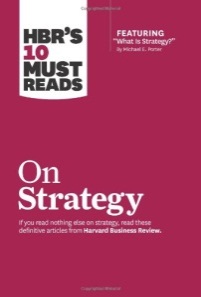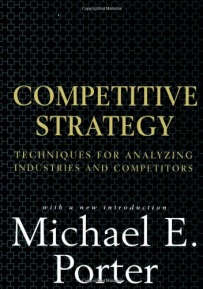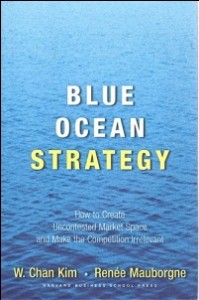We read – a lot. Unfortunately, some books seem to try too hard – filling 200 pages with a simple idea that the author beats to death. Some are provocative simply to push sales. Some, however, are powerful, timeless and packed with new and useful insights and prescriptions. And a few are older classics that still resonate today. We share our “must read” library below and provide links to Amazon to buy – and, no we don’t earn a commission.
HBR’s 10 Must Reads on Strategy
Excellent

You know that we love the Harvard Business Review. We follow them on Twitter, subscribe to the magazine (our other favorite is the Economist – the best newspaper on the planet), peruse their blogs and we look out for their publications. The HBR has access to a very wide array of authors and articles and regularly selects the best to publish as a group. If you really want to take control over the unwieldy beast that Strategic Planning seems to be, read this (and the other titles below). Buy this book …
Competitive Strategy: Techniques for Analyzing Industries and Competitors
Essential Must Read
 This is the strategy bible. A serious work for people who are serious about corporate strategy development. Don’t let management fad-du-jour strategy fashionistas tell you that Porter is out of date or old fashioned. This book, in its 60th printing in English and translated into nineteen languages was a breakthrough when first published and remains an essential read. This is not light stuff, but it is very well written and presented, very detailed and there are kernels of brilliance here.
This is the strategy bible. A serious work for people who are serious about corporate strategy development. Don’t let management fad-du-jour strategy fashionistas tell you that Porter is out of date or old fashioned. This book, in its 60th printing in English and translated into nineteen languages was a breakthrough when first published and remains an essential read. This is not light stuff, but it is very well written and presented, very detailed and there are kernels of brilliance here.
Some will argue that there are more than the five forces that Porter describes. Even I have tinkered with a sixth force, but really we are tinkering on the margins of an extremely useful model.
We also believe that you should read “Blue Ocean Strategy”, which is new and takes a very different approach. Beware, however, blue oceans eventually turn red, and when they do, Porter’s five forces reappear. Truth be told, they never really go away, regardless of how innovative or disruptive you are (or think you are). Read our blog article “Porter vs. the Blue Ocean” for more on how these two are really complementary, not competitive perspectives.
While you are at it, consider Porter’s three generic strategies (a tool that we use and teach). Search on Amazon and you will find companion books and other works by Porter (“On Competition” and “Understanding Michael Porter: The Essential Guide to Competition and Strategy”). In fact, the featured article in ” HBR’S 10 Must Reads On Strategy” is written by Michael Porter, a Harvard Professor. Buy this book …
Blue Ocean Strategy: How to Create Uncontested Market Space and Make Competition Irrelevant
Essential Must Read
 This is one of those books that leaves you wondering how you could have failed to come up with this idea yourself. It seems so obvious and intuitive. The authors describe most markets as Red Oceans – red because they are filled with competitors who share similar paradigms and can only really grow market share by attacking or devouring their competitors – thus the water is red. Blue oceans are untapped markets, ripe for growth.
This is one of those books that leaves you wondering how you could have failed to come up with this idea yourself. It seems so obvious and intuitive. The authors describe most markets as Red Oceans – red because they are filled with competitors who share similar paradigms and can only really grow market share by attacking or devouring their competitors – thus the water is red. Blue oceans are untapped markets, ripe for growth.
You might think that the very concept of an untapped market is a dream, but there are numerous examples of innovators and disruptors who have either tapped into evolving behavioural shifts, or have actually caused markets to shift towards their new product or service model by leveraging what the authors call “value innovation”.
This is an easy read and an inspirational work. It does not have the heft and depth of Porter’s “Competitive Strategy”, but it certainly makes our “must read” list. There is a brilliant simplicity in the Blue Ocean concept and we strongly recommend pursuing this line of thought whenever you are addressing new market and growth strategy options.
That said, don’t burn the rest of your strategy library. While this is a powerful approach, it must be employed in conjunction with a range of other, established, strategy tools and methodologies. In fact, good old Porter’s five forces model is nicely complementary. If you are lucky enough (smart and persistent enough) to find or create a true blue ocean, you can be assured that the competition will notice and follow, and the water will start to turn red over time, with all of the classic competitive forces coming back into play. Buy this book …
More to come
We have a lot of books in the library and will post more reviews in the coming months. We will post links to new reviews on our Neural Net blog.
